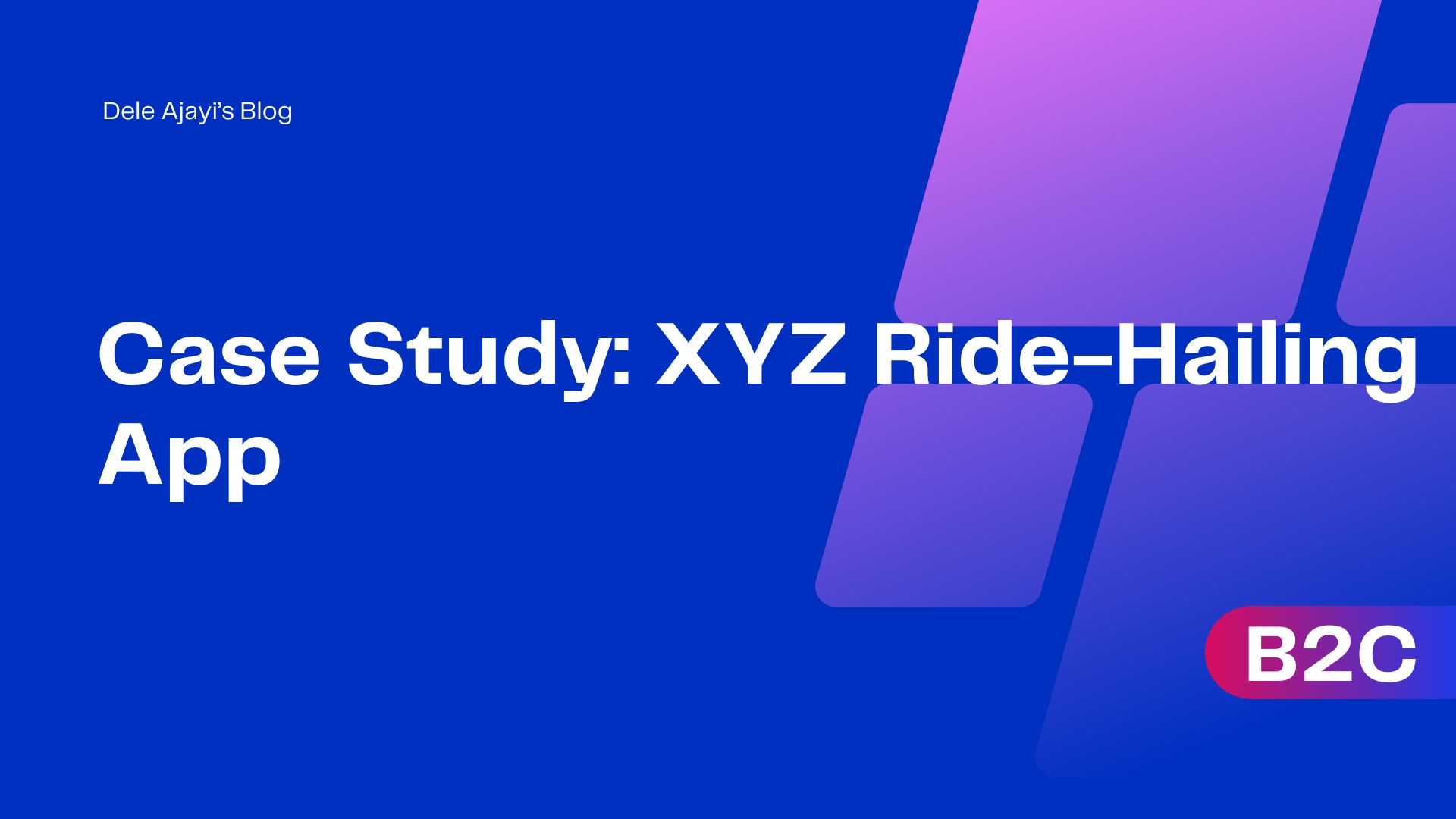Case Study: XYZ Ride sharing App
 Dele Ajayi
Dele Ajayi
Introduction 👋:
In the bustling urban landscapes where time is of the essence, XYZ emerges as a game-changer in the world of ride-hailing apps. XYZ strives to redefine the way people commute, focusing on seamless experiences, safety, and efficiency. This case study delves into the evolution of XYZ, from identifying a prevalent problem to implementing an innovative solution.
User Persona 👩🦰:
Meet Sarah, a 32-year-old working professional living in a metropolis. Sarah juggles between her job, social life, and family commitments. She values her time and seeks a reliable, convenient, and safe transportation option. XYZ Ride-Hailing App aims to cater for Sarah's needs and those of millions like her, ensuring a hassle-free and enjoyable journey.
Problem: Urban commuters faced challenges with traditional transportation modes – long wait times, uncertain availability, and safety concerns. Existing ride-hailing apps lacked the holistic approach needed to address these issues.
Solution: XYZ Ride-Hailing App was conceived as a user-centric solution. With advanced algorithms, real-time tracking, and stringent safety measures, XYZ ensured a reliable, secure, and timely transportation option for users like Sarah.
Product Features:
Real-Time Tracking: Users can track their ride's location in real-time, enhancing transparency and security.
Smart Matching Algorithm: XYZ's algorithm ensures the most efficient route, reducing wait times and travel durations.
Real-Time Messaging and In-App Calls: Users can chat and communicate directly with the driver. Also, the app gives access to call the driver in-app without wasting airtime.
Dynamic Pricing: Users can bargain ride prices with the driver before he/she accepts the ride if the price is ideal for the driver.
Enhanced Safety Measures: Proper driver background checks, SOS features, and real-time emergency assistance contribute to a secure environment.
User-Friendly Interface: A seamless and intuitive app interface guarantees a hassle-free experience for both drivers and passengers.
Metrics and KPIs:
- User Acquisition and Retention:
Downloads: Number of app installations.
Active Users: Number of users actively using the app.
Customer Retention Rate: Percentage of users retained over a specific period.
Booking Metrics:
Daily/Weekly/Monthly Bookings: Total number of completed rides.
Booking Conversion Rate: Percentage of app sessions that result in a completed booking.
Service Availability:
Fleet Utilization: Percentage of time the fleet is actively engaged in providing rides.
Service Uptime: The percentage of time the app and services are operational.
Driver Metrics:
Driver Availability: Percentage of time drivers are available for rides.
Driver Ratings: Average ratings given by passengers to drivers.
Driver Acceptance Rate: Percentage of ride requests accepted by drivers.
Trip Metrics:
Average Trip Duration: Average time taken for completed trips.
Average Waiting Time: Time passengers wait for a ride.
Cancellation Rate: Percentage of bookings canceled by either party.
Safety Metrics:
Incident Rate: Number of safety incidents per completed trip.
Driver Background Checks: Percentage of drivers who have undergone background checks.
Financial Metrics:
Revenue per Trip: Average earnings per completed trip.
Total Revenue: Overall revenue generated by the ride-hailing service.
Customer Satisfaction:
Customer Ratings: Average ratings given by passengers for the entire ride experience.
Customer Support Response Time: Time taken to respond to customer support queries.
Geographic Metrics:
Peak Demand Locations: Identify high-demand areas and times.
Service Coverage: Evaluate the app's coverage in different geographic regions.
Operational Efficiency:
Average Pickup Time: Time taken for a driver to arrive at the pickup location.
Average Drop-off Time: Time taken for a completed trip from pickup to drop-off.
Cost Metrics:
Cost per Mile/Kilometer: Operational cost per distance traveled.
Cost per Acquisition (CPA): Cost of acquiring a new customer.
Technology and App Performance:
App Load Time: Time taken for the app to load.
App Crash Rate: Frequency of app crashes.
Roadmap: Quarterly Development Plan
Quarter 1:
Conduct user surveys to gather feedback on pain points.
Implement minor app interface enhancements based on user feedback.
Quarter 2:
Introduce an upgraded algorithm for smarter ride matching.
Collaborate with local law enforcement agencies to enhance safety measures.
Quarter 3:
Launch a targeted marketing campaign to increase user base.
Roll out a loyalty program to retain existing users.
Quarter 4:
Integrate AI-driven predictive analysis to further reduce wait times.
Launch a referral program to incentivize existing users to bring in new customers.
Product Lifecycle Phases:
Introduction:
Initial market research and user identification.
Launch of the basic XYZ app with fundamental features.
Growth:
Continuous user feedback and feature enhancements.
Expansion of user base through marketing initiatives.
Maturity:
Introduction of advanced features and loyalty programs.
Optimization of operations for efficiency and cost-effectiveness.
Decline or Renewal:
Continuous monitoring of user satisfaction and market trends.
Introduction of innovative features to stay competitive.
In conclusion, XYZ Ride-Hailing App stands as a testament to innovation in urban mobility, catering to the evolving needs of users like Sarah. By addressing key pain points, implementing user-driven features, and setting measurable KPIs, XYZ paves the way for a future where commuting is not just a necessity but an enjoyable experience.
Subscribe to my newsletter
Read articles from Dele Ajayi directly inside your inbox. Subscribe to the newsletter, and don't miss out.
Written by
